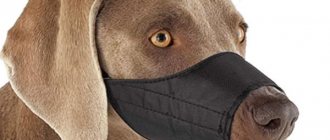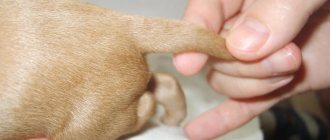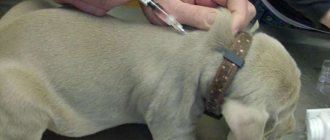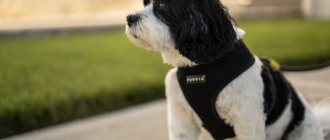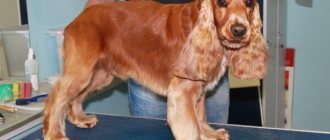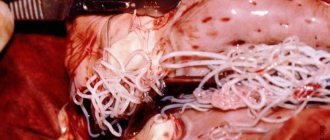There are several methods for introducing solutions into the intestines. A deep or siphon enema is prescribed and performed only by a veterinarian. But a shallow enema for a dog is a relatively simple procedure: the owner himself can help the pet if an urgent need arises. But first you need to carefully study all the instructions in order to clearly understand what you are doing and why.
Constipation symptoms
It is often impossible to give an enema. This will lead to a weakening of the natural bowel movements. You should study the symptoms by which stool disorders can be determined. There are several obvious signs of constipation in a dog:
- bloating, rumbling;
- during defecation, feces come out in small quantities, it is dry, hard, and shaped like balls;
- there is no defecation, although the dog sits down and strains strongly;
- appetite worsens, nausea and vomiting are possible;
- when you touch the pet’s belly, he shows that it is unpleasant for him;
- the general state is depressed, there is no activity, the dog does not want to follow commands even for a favorite treat.
The presence of constipation may be indicated by the absence of bowel movements for 3 days, provided that the diet is normal.
An enema can be used to combat constipation no more than three times a month. If stool disturbances occur regularly, it is necessary to make a visit to the veterinary clinic. The specialist will determine the cause of constipation and select laxatives and the optimal dosage for the dog.
It is advisable to carry out this procedure in the morning, within an hour after getting up, if the pet was unable to empty its bowels during a walk. If you have to do the enema during the day or evening, you need to wait about two hours after feeding. The procedure cannot be performed on a full stomach.
What you need to know about the effects of an enema
An enema is the use of a special device to introduce liquid into the rectum. It acts both prophylactically and for the treatment of certain diseases. With its help you can:
- Cleanse the intestines of parasites and accumulated feces, and also have an antioxidant effect on the body as a whole.
- Stimulate intestinal motility. The use of various substances can create an enveloping effect and have a healing effect in the presence of injuries or inflammatory processes.
- Maintain normal water balance during cerebral edema and heat stroke.
What is injected into the intestines?
If there is a need to give your dog a shallow enema, this can be done at home. The dog is given microenemas with medications after cleansing the intestines, in order to prevent infectious diseases. Usually the pet does not feel discomfort and tolerates this procedure normally.
In cases where the dog cannot eat or take food in the usual way, the animal is infused with small doses of glucose, saline solution in combination with broth or liquid food. Due to the fact that a small amount of nutrients is absorbed in the large intestine, this method is not very popular today. In the postoperative period, the dog is prescribed these measures to facilitate the process of defecation. Indeed, during the process, the animal’s seams may come apart.
Contraindications
An enema is a simple procedure, but there are contraindications to it. It cannot be carried out if:
- there are parasites;
- the body is dehydrated;
- there are cracks in the intestines, hemorrhoids, intestinal ulcers;
- Acute inflammation of the digestive system is observed.
It should not be given to dogs that have cancerous tumors in the intestines, internal bleeding, or pregnant bitches.
There are several symptoms that can be used to determine that your pet should not undergo the procedure. An enema is contraindicated if the dog has:
- increased temperature (normal value for puppies is 39.5°C, for adults – 39°C);
- increased feeling of thirst;
- mucous membranes have a bluish tint and are dry;
- blood is released from the anus;
- increased blood pressure (normal values depend on size and are 95-135/60-100);
- tachycardia (the norm for puppies is 220, for older dogs – 110, for an adult dog – 130 beats per minute);
- coordination is impaired;
- convulsions are observed;
- nausea and vomiting;
- severe abdominal pain, the dog does not allow you to touch the abdominal area;
- breathing is heavy even in the absence of movement.
If you have these signs, you should immediately contact your veterinarian. They can be the result of serious illnesses, internal bleeding, etc.
What volume should I choose?
The “pear” is filled with water brought to 37°C, cold water – to 29°C. The amount is determined by the size of the dog and the type of enema used.
| Dog size | Volume, ml |
| Large | 1000 |
| Average | 250 |
| Small | 50 |
Therapeutic microenemas are made for rapid absorption of administered medications; their volume does not exceed 0.05 liters and depends on the breed.
Devices and means for the procedure
You need to prepare for the colon cleansing procedure so that everything you need is at hand. It will require:
- enema;
- water or solution;
- cream or Vaseline;
- surgical gloves;
- diapers, newspapers;
- basin of the required capacity;
- dog accessories (collar or harness, muzzle, leash).
If an enema is given to a puppy, then you can use a 10 ml syringe. For small dogs, an enema is given with a 100 ml syringe; for medium-sized animals, a 200 ml syringe is needed. A large pet needs a special device called an Esmarch mug. The device looks like a heating pad with a tube and tip.
The procedure can use boiled water cooled to 30°C. It is advisable not to rely on your feelings; measure this indicator with a thermometer. If your dog has severe constipation, solutions should be used instead of water. It could be:
- boiled water with salt or soda (dilute a tablespoon of the product in a glass of water);
- a strained, cooled decoction of St. John's wort or chamomile, prepared from a glass of water and a tablespoon of dried flowers;
- a solution with petroleum jelly or glycerin (add a tablespoon of the product to a glass of water);
- an aqueous solution with fish oil (a tablespoon of the product per glass of cooled boiling water).
Vaseline or cream will be required to lubricate the tip of the syringe or syringe before insertion. Before the procedure, you need to put on a collar or harness, a muzzle, and a leash on the dog, because how the pet will behave is unknown. Large adult pets cannot be given an enema alone. An assistant is needed to hold the dog. The owner needs to be calm, attentive, and should not shout at the dog, increasing stress.
Solution for administration
In each individual case, you need to prepare a special solution. It is done immediately before the procedure. There are several types of solution:
1. Warm saline solution, which is made from magnesia (20 grams) and regular table salt (30 grams). The salt mixture is diluted with water (100 ml) and melted over low heat. The solution is administered slightly warm.
2. Saline solution, which is prepared from table salt (30 grams) and water (1 liter). If you need a strong effect right away, you can additionally use another 10 grams of salt. The solution is introduced gradually in 50 ml increments.
3. Soap solution, which is prepared from water (1 liter) and grated baby soap (1 tablespoon). It is baby or laundry soap (light) that has a neutral pH and can easily be used for a dog enema. Such a solution cannot damage the intestines, and the soap does not have dyes or harmful additives.
4. Chamomile solution. Chamomile powder (1 tablespoon) is poured with boiling water (1 liter) and left for about 30 minutes. Then you need to carefully strain the solution through cheesecloth to avoid chamomile getting inside. The solution must be administered warm.
5. Glycerin solution. Glycerin (1 tablespoon) is diluted with water (1 liter), mixed thoroughly and poured into an enema for dogs.
Any of the above options must be chosen by a veterinarian who will ensure the safety of the procedure. Each solution has its own contraindications, which depend on the different conditions of the dogs. Before use, the liquid must be heated, the temperature should not exceed 25 degrees.
In cases of using an enema to remove feces and possible mucus, take a siphon enema, which is heated to 40 degrees. This allows you to get rid of various microorganisms and toxins.
Sequence of the procedure
It is advisable to carry out the procedure in the bathroom. First you need to prepare a basin in which the feces will be collected. The floors need to be covered, for which use old newspapers that absorb diapers. The thickness and number of layers depend on the size of the animal. After preparation, you can begin the procedure. The algorithm of actions is as follows:
- Fill a syringe, syringe or Esmarch mug with prepared water or solution;
- Fix Esmarch's mug at a height of 1 meter;
- lubricate the tip of a syringe or syringe with Vaseline or cream;
- put a collar or harness or muzzle on the dog;
- gently lay the pet on its side;
- pet the dog, put him to rest;
- wear surgical gloves;
- the assistant must hold the animal’s neck and front paws;
- pour some water out of the enema to remove air;
- insert the tip into the anus to the optimal depth (puppies - 1 cm, medium-sized dogs - 2 cm, large dogs - 4 cm);
- slowly, gradually introduce the solution into the intestines;
- After the procedure, carefully remove the tip.
The liquid should be well distributed throughout the intestines, for which the animal needs to lie quietly for a quarter of an hour. If the dog has a tail, you should cover the anus with it. After this, the animal should get up, you can remove the muzzle and harness. At this moment, defecation should begin, so it is necessary to move the pelvis and place the dog’s hind legs in it. After emptying the intestines, you can clean up and remove the seals. If the dog is good at bathing, it is worth carrying out this procedure after the enema. The pet also deserved generous praise for his endurance and patience.
An enema is not considered an overly complicated procedure. But it should be taken into account that if problems arise when pouring liquid, there is a feeling that it is colliding with something solid, it is pouring out, you need to stop manipulation. The dog's intestines may be heavily filled with worms or there may be a foreign object in it. Filling the intestine with water can damage it. If there is no bowel movement after the enema or there is blood in the stool, you should immediately contact a veterinary clinic.
Errors in care
Dogs often suffer from digestive disorders as a result of improper diet management, this can be:
- excess bones, which can clog the intestinal lumens;
- deficiency of dietary fiber if a natural diet is used for feeding;
- insufficient amount of water (especially if the animal eats dry granulated food), etc.
In addition, dogs that do not lead a very active lifestyle, in particular those living in apartment buildings with infrequent walks, suffer from frequent constipation.
Animals that regularly experience stress are at risk of developing problems with the gastrointestinal tract; this could be due to a move, the death of an owner or a change of owner, the purchase of a new animal, or other reasons. Constipation in a puppy can be caused by ingestion of foreign objects, which they absorb due to excessive curiosity, lack of calcium and other minerals and vitamins.
Diseases
Constipation in a dog can be a consequence of various diseases, and they are not necessarily directly related to the gastrointestinal tract.
Often problems with bowel movements develop against the background of diseases of the nervous system:
- spinal injuries;
- inflammatory process localized in the paraanal glands;
- inflammation of the gastric mucosa;
- helminthiasis (thick balls formed by helminths can clog the intestinal lumen);
- pathologies of the genitourinary system;
- lesions of the pancreas;
- excessive thinness or obesity;
- oncological diseases;
- paralysis, etc.
Often a dog has difficulty going to the toilet as a result of improper drug therapy; it is enough to change the course of treatment and intestinal function will be restored.
Drug treatment for dogs
Despite the apparent frivolity of the situation, constipation can lead to global consequences, so treatment must be timely and effective.
Quick-acting laxatives are used to relieve the dog of symptoms of intoxication or prolonged hunger. The following groups of drugs are prescribed:
- for acute constipation, saline laxatives;
- preparations containing plant and mineral oil components;
- prebiotics, which do not act so quickly, but have a gentle effect.
Among the drugs approved for use in veterinary medicine are Magnesium Sulfate, Sodium Sulfate, Vaseline, castor oil, Bimin, Duphalac, Lactusan, Microlax, Mucofalk, Bisacodyl. The dosage and duration of therapy is determined by the attending physician.
Physiological reasons for the absence of bowel movements
Intestinal motility may be disrupted due to physiological reasons, such as:
- Pregnancy. The uterus of a pregnant bitch can put pressure on the intestinal loops, thereby disrupting the natural movement of feces. Moisture is absorbed by the intestinal walls, the masses become hard, thick and cannot naturally pass through the anus.
- Estrus. During estrus, dogs experience severe hormonal changes, which can affect the functioning of the gastrointestinal tract.
- Elderly age. In old dogs, intestinal motility worsens with age, which is facilitated by the rapid decline of vital systems and concomitant chronic diseases.
Throughout the postoperative period, the dog often suffers from stool retention. After general anesthesia, the tone of the intestinal muscles is not restored immediately; excessive straining may be accompanied by painful sensations, which can lead to constipation.
